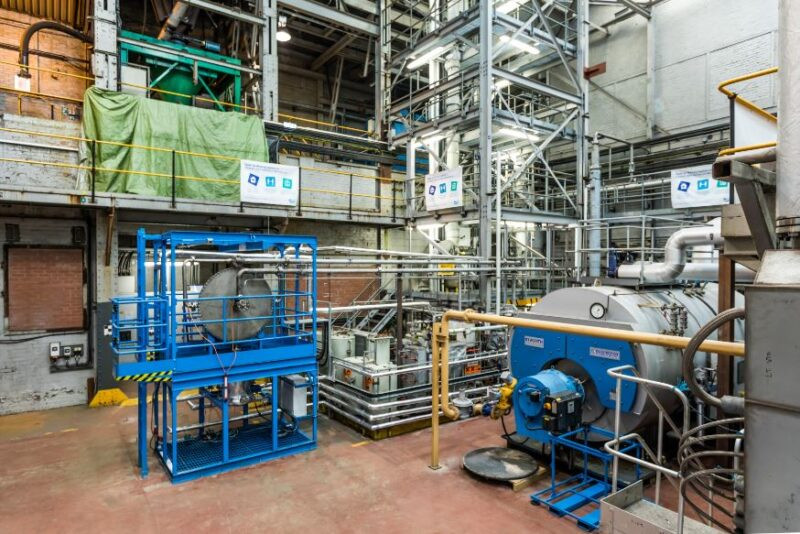Clouds can trap heat or reflect it away from Earth, making their impact on global warming extraordinarily hard to predict. Now, new ways of studying them are lifting the fog.
One of the rare places in New York City where you can get a good view of clouds is the Central Park reservoir. Looking north from its edge, a gap between the buildings is wide enough to see them roll in from the harbor. This is where climate scientist Kara Lamb suggests we meet for a bit of cloud watching.
When we do, the sky is crowded with fluffy cumulus beneath a ceiling of altostratus – one, I venture, is very like a whale. But Lamb, who studies clouds at the city’s Columbia University, sees something less whimsical. “Clouds are fascinating because they are cool to look at,” she says. “But I think about them more from a climate perspective.” That means making sense of how the sunlight they reflect and the heat they trap below influences Earth’s temperature.
What casual cloud watchers may not know is that determining how this balance will change in a warming world makes clouds the biggest unknown in predicting future climate change. Will the world warm by a manageable 1.5°C or a hellish 4.5°C, given a doubling of carbon dioxide from pre-industrial levels? Our poor grasp of clouds is the biggest culprit regarding this uncertainty.
But researchers are making progress. Lamb, for one, is focused on ice crystals in clouds, which play a surprisingly large role in their climate impact. Others use cloud chambers, with plans for one…
Climate Modeling and Intervention
Scientists say the global climate crisis is continuing to intensify, and managing the situation requires increasingly innovative solutions. While governments wrestle with setting new policies, non-governmental organizations are finding innovative ideas using the technology available to meet these challenges. Supercomputing is one of the technologies that can power progress, serving as a pathway to solutions through climate modeling, data analysis and the application of artificial intelligence.
SilverLining’s Research
To learn about how these technologies are being used to accelerate climate action, we spoke with Jean-François Lamarque, who serves as chief climate scientist at SilverLining, an organization whose mission is to promote safety for the world’s people and natural systems in the context of near-term climate risks – that is, over the next one to three decades.
“SilverLining’s mission is to accelerate scientific research to improve our understanding of near-term climate risks and potential interventions in the climate system to reduce them. This includes research on increasing the reflection of sunlight from clouds and particles in the atmosphere to cool climate, sometimes called ‘solar radiation modification,’ or SRM,” Lamarque explains.
Under that umbrella, Lamarque says that SilverLining works with a community of scientists to research approaches like dispersing particles to reflect sunlight from the stratosphere (Stratospheric Aerosol Injection) and dispersing sea-salt mist into low clouds over the ocean to increase their reflection of sunlight (Marine Cloud Brightening). SilverLining’s Safe Climate Research Initiative is an effort to explore and evaluate these and other climate interventions to mitigate global warming.
Supercomputing for Climate Modeling
A central part of this work is the simulation of Earth’s climate over time in probable scenarios for climate change, and of the climate with different scenarios for intervention. “We use large earth system models to perform these simulations together with high resolution models of key parts of the system like the stratosphere,” says Lamarque, who says that these models are some of the largest high-performance computing workloads in existence. With the sheer volume of processing and data involved in climate modeling and data analysis – often scaling to many terabytes and even petabytes – HPC is a critical technology used in studying both climate and climate interventions.
“Today this work is done largely in specialized supercomputing facilities, like the one used by the National Center for Atmospheric Research, where I used to lead this type of work,” Lamarque shared. This means that most researchers globally, and many in the US, are limited in the type of climate research they can do, because they lack access to HPC. This bottleneck limits progress on all areas of climate research and action, and creates a structural inequity in who can undertake and lead climate science.
SilverLining is dedicated to ensuring that society has information and options to address near-term climate risk to protect vulnerable people and sustain natural systems for the future.
Climate Impacts
A significant part of SilverLining’s research involves examining and projecting climate impacts – damage to human and natural systems, and tipping points, critical thresholds that, when crossed, can lead to catastrophic and irreversible changes in Earth’s climate system.
“When we talk about impacts, we’re referring to the different conditions – heat, storms, loss of plant and animal life where conditions become increasingly unbearable for many around the globe,” says Lamarque. “People die, or are displaced, or cannot work.” He further outlines the risks of major catastrophic change, explaining there are physical tipping points, like the sensitivity of heat transport in the oceans, ice sheets melting, or the disappearance of sea ice in the Arctic.
“From the satellite records since the 1970s, we see that sea ice has been decreasing, especially in late summer,” he adds, explaining these tipping points are central to SilverLining’s research as they assess potential climate intervention methods to mitigate such risks. The goal is to provide temporary measures while emission reduction strategies are developed.
“While carbon dioxide emissions are going down, it’s not currently as fast as we understand we need for a safe climate,” Lamarque warns. “It’s pretty much a given now that we will exceed 1.5°C as a global average measure in the next decade or two, which official bodies describe as a key threshold for more severe climate impacts.”
Notably, Earth’s average temperature has already temporarily crossed this critical threshold.
“Climate modeling and analysis have shown that with every increase in warming, there’s an increased risk of detrimental effects,” Lamarque notes. These effects include more frequent and intense heat waves, particularly in vulnerable regions, which can have devastating consequences. “We are still working to understand the impacts of this warming and to help people around the world understand what it means for them,” he says. “By researching climate intervention methods such as solar radiation modification, we can help explore their potential to temporarily alleviate some of these extreme impacts, buying time for more sustainable solutions to take effect.
The Promise of Cloud Supercomputing
While climate projections are dangerously concerning, scientists around the world are not taking the problem sitting down – except, of course, when they are seated behind powerful HPC workstations, crunching away on simulations to find ways to respond to these changes. Supercomputing, including HPC in the cloud, provides an essential backbone to SilverLining’s research initiatives.
By harnessing the power of cloud supercomputing capabilities, along with some of the brightest minds available, SilverLining can work with academics around the globe and help run comprehensive climate models that integrate an immense amount of data to evaluate the efficacy of various climate interventions.
“Climate intervention is seen as a potential way to reduce the risk for maybe a decade or two, while we find ways to reduce emissions,” Lamarque explains. “It’s not a long-term solution – more like a patch for 10, 20, maybe 30 years, combined with emission reductions, to maintain something like the current climate.” This requires rigorous testing and validation to mitigate any potential risks and ensure that any proposed remedies are both safe and effective.
As part of its Assessing Responses and Impacts of Solar climate intervention on the Earth system (ARISE) research program, in partnership with Amazon Web Services, the National Center for Atmospheric Research, and the University of Washington, SilverLining supported the deployment and first-ever full production climate model simulations on the commercial cloud.
“High-performance computing is indispensable for our climate research,” Lamarque explains. “We have conducted large-scale simulations on these systems, utilizing millions of core hours to run full-fledged climate models effectively. This shift to cloud-based HPC allows us to perform extensive simulations that were previously only possible on traditional supercomputers, paving the way for accelerating innovative climate solutions. We have performed most of our simulations using the cloud. To our knowledge, we were the first to effectively run a full-fledged climate model on a cloud computing system.”
Democratizing Climate Modeling
While supercomputers on location at large research institutions have been the standard for decades, cloud-based HPC is democratizing climate modeling giving organizations, especially in the global south, that may not have been able to afford these powerful systems access to significant computing capabilities without the need to invest in and maintain expensive onsite infrastructure.
SilverLining’s efforts have resulted in the creation of over 1,000 years of climate simulation data, utilizing around 10 million core hours and generating hundreds of terabytes of data, says Lamarque. Of course, these results come with their own set of challenges.
Challenges and Opportunities
Leveraging HPC for climate research, like SilverLining did in partnership with Amazon Web Services is not without obstacles. SilverLining has faced both technical and practical challenges. Given the simulations generate vast amounts of data that must be efficiently stored and analyzed, data management and accessibility are critical issues. Energy concerns also are top of mind for climate researchers, given the substantial power consumption of these large-scale computing systems.’
“Energy consumption is a hard challenge,” Lamarque admits. “One approach is moving to GPUs, which tend to be more efficient.” This is a major challenge as transitioning from CPU- to GPU-optimized code requires substantial rewrites and testing. Most of the code, which has been in use for decades, is CPU-optimized, but the transition is essential for improving computational efficiency. This demands extensive resources and time.”
If they can use the cloud, scientists could take advantage of ongoing HPC innovations made by cloud providers to address performance, efficiency and other constraints. But deployment on the cloud is a major challenge in and of itself, and for major climate models, which are massive in size, whose code is not cloud-native, and which require processing that cannot be easily distributed, deployment on the cloud required a substantial technical effort that included experts in the climate model software, in HPC in general, and in AWS infrastructure specifically.
While integrating new technologies like cloud computing presents both opportunities and challenges – and Lamarque anticipates much more development other emerging technologies such as AI for emulating climate models – a chief challenge remains in ensuring the safety of the proposed climate interventions.
The Future of Climate Modeling
Despite these numerous challenges, the future of climate modeling and intervention research is promising. Cloud computing is opening doors to overcoming current obstacles in previously unavailable ways. As organizations like SilverLining and its cohorts continue to break ground in finding innovative fixes, other areas of science and technology researchers are using supercomputing to drive progress and tackle complex challenges.
Lamarque captures this optimism perfectly: “I believe we’re on the verge of a significant revolution in how climate modeling and climate research is done. This is especially true for communities around the globe that have not had access to supercomputing and therefore not had proper access to climate models and data. The integration of AI and advanced computing technologies is poised to transform our ability to understand and address climate change, providing us with powerful tools to develop innovative solutions and mitigate the impacts of this global crisis.”


















